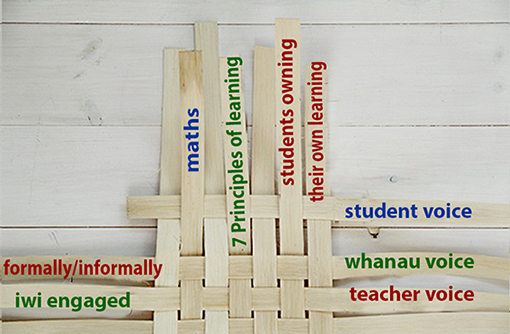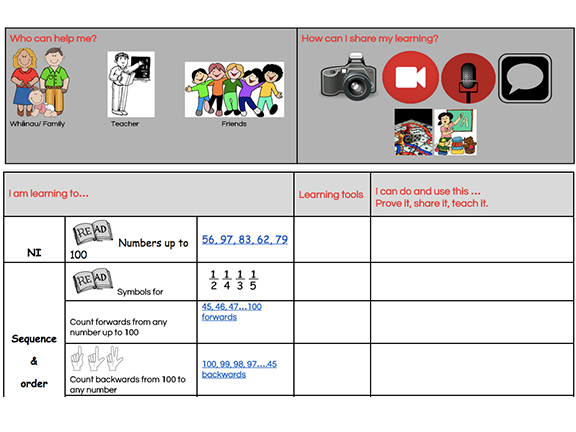Primary school teachers use maths assessment to increase student agency
Tags: Teacher inquiry | Collaborative tools | Primary |
Roydvale and Wairakei primary schools inquired into ways of helping students gain ownership over their learning. They used Timperly, Halbert and Kaser’s (2014) Spirals of Inquiry as a framework for their inquiry.
Lenses used in the inquiry
The vertical strands indicate the lenses used within the inquiry:
- Maths curriculum
- 7 Principles of Learning
- Student agency
The horizontal strands represent the relationships built throughout the inquiry.
The Hereora Community of Learners
Roydvale and Wairakei primary schools are part of the Hereora Community of Learners (CoL). One of the māhi ngā tahi or "common cause collaborations" across the Hereora CoL is to explore student agency. The Hereora CoL is made up of:
Three early childhood services:
- Kidsfirst Kindergartens, Isleworth Rd
- Kidsfirst Kindergartens, Kendal Ave
- Bishopdale Preschool
Five primary schools:
- Isleworth
- Roydvale
- Harewood
- Wairakei
- Breens Intermediate
One high school:
- Burnside High
Scanning: Finding out how assessment tools affect learning
Hereora leaders began their inquiry into student agency by analysing their current assessment tools for maths. They wanted to find out how useful teachers, students, and parents found the assessments.
Usefulness of assessment tools towards building student agency
This graph shows how useful parents, teachers, and students find the school's current assessment tools.
- Bars: Level of usefulness according to parents, teachers, and students.
- X axis: Assessment tools.
- Y axis: Degree of usefulness, indicated by point score.
Making sense of the data
The leaders collaborated to make sense of the data they had collected. They asked the following questions:
- What was meant by "useful"?
- What tools were useful for everyone?
- What was useful for the parents?
- How significant was the usefulness of the data if shared with the students?
They agreed that assessment tools were useful when they:
- helped students talk about their learning
- encouraged students to self-manage by setting specific goals
- helped students construct learning pathways.
Focusing: What emerges from the data
Common problems in assessment
- When asked, target students could not articulate where they were with their maths learning.
- Most assessment tools were for professional use only.
- Some assessments were duplicated.
- Very few assessments were shared with students to help them set goals or construct personalised learning pathways.
“Assessment for teachers are good for next steps and planning, finding out where the children are at. But what are we assessing for? Reporting? Planning? Informing our teaching? Or empowering the children?”
Wairakei Teachers
Developing a hunch: Identifying problems
Leaders share the data they collected
The leadership team met to share the data they collected. They shared:
- learner maps
- student surveys about attitudes to maths
- parent conversations
- learning comments and reflections.
"When teachers are provided with opportunities to use and interpret a range of evidence in order to become more responsive to their students’ learning needs, the impact is substantial."
― Helen Timperley, (2010). Using evidence in the classroom for professional learning
Outcomes of data-sharing
By consulting students and whānau directly, the schools' leadership teams learned that students engaged highly with maths and generally had a positive attitude towards it. However, this wasn’t matched by achievement. There were still children who didn't understand how to improve their level of mathematical understanding.
Understanding the problem: Lack of student agency
The schools realised that they lacked child-friendly language for mathematical progressions. Students still didn’t have the ability to talk about their learning in maths.
The teams used Joan Daltonʻs Learning Talk resources to continue the inquiry and build communication. The Wairakei leadership team also examined their own teaching practices and what was leading to the current situation. The leadership team asked themselves how they might shift their mindset from "I must do this for national standards" towards "how can I support children to self-manage with their maths?"
Using digital technologies to put learners at the centre
Both schools wanted to put their students at the centre of maths learning. They wanted their teachers and students to co-design maths learning together.
The Roydvale leadership team use IKAN Maths to make assessment student-centred
The Roydvale team wanted learners to "get inside" mathematics by exploring rich maths tasks . They wanted to shift the subject away from procedures and facts and turn it into an authentic, connected whole.
They used the IKAN Maths knowledge progression sheets to help students:
- know where they are with their maths and where they are going
- engage with assessment practices alongside their whānau
- have ownership over their maths learning and assessment
- articulate maths knowledge and strategies
- backwards map knowledge and strategies from rich maths tasks.
The Wairakei leadership team use student-plus-teacher workshops to put learners in the driver's seat
The Wairakei leadership realised that students didn’t know where they were with their learning or where they were going. They wanted to co-create pathways for learning maths with their students. They wanted to put learners in the driver's seat. This would lead to:
- greater engagement and intrinsic motivation
- students setting higher challenges for themselves
- students evaluating their own work
- better problem-solving.
For further research on putting learner's in the driver's seat:
- Watkins, C. (2009). Learners in the driving seat. School Leadership Today,1:2, 28-31. Retrieved from Teaching Times .
- Ryan, R.M. & Deci, E.L. (2000). Intrinsic and extrinsic motivations: classic definitions and new directions. Contemporary Educational Psychology, 25, 54–67.
- Boggiano, A.K., Main, D.S., & Katz, P.A. (1988). Children’s preference for challenge: the role of perceived competence and control. Journal of Personality and Social Psychology, 54:1, 134–141.
- Boggiano, A.K., & Katz, P.A. (1991). Maladaptive achievement patterns in students: The role of teachers’ controlling strategies. Journal of Social Issues, 47:4, 35–51.
- Boggiano, A.K., Flink, C., & Shields, A. et al. (1993). Use of techniques promoting students’ self-determination: effects on students’ analytic problem-solving skills. Motivation and Emotion, 17, 319–336.
Google Docs for student-plus-teacher workshops
Warakei held student-plus-teacher workshops to co-create a pathway for learning. In the workshop they used a Google doc for students to reflect on their learning and link resources. They were prompted to ask:
How can students share their learning (photograph it, video it, make a game, teach others, show and explain how the knowledge is used in real life)?
- Who can help (parents/whanau/ teachers/ friends)?
- How could they record evidence of what they have learned (proving, sharing and teaching)?
- What learning tools and other digital resources could be linked by students and teachers to the google document (YouTube videos, interactive games)?
- What maths knowledge did they use in rich maths tasks or in learning sessions?
- What are they learning now?
- What are the next steps?
At the workshop, teachers and students discovered that digital technologies enabled studentsʻ ownership of the learning and assessment. They provided a way to:
- share and engage learning (for example, via Google docs)
- reflect on learning (by both teachers and students)
- capture evidence of learning
- share their learning with whānau
- connect to online learning resources
- teach others.
The following strategies and tools continue to inform the inquiry and measure the impact of changes on teaching and learning:
Taking action: Implementing change
Co-construct, collaborate, and coach: Themes for guiding change
The initial student-teacher workshops held by Wairakei showed that placing students at the center of their learning was going to be a long journey.
The leadership teams agreed that assessment should be changed according to the following three themes:
- Co-construct: How can teachers and students co-construct ways to share their maths knowledge, learning and understanding? How can teachers scaffold students’ ownership of assessment?
- Collaborate: How can students collaborate on their learning by working in groups and teaching others?
- Coach: How can peers and parents – as well as teachers – be supported to coach students using some of the following questions:
- What is the problem?
- What do you need to know to solve the problem?
- Have you seen this problem in other situations?
- Who uses that? What might you be able to do with it?
- How could we best learn that?
- What tools or strategies do you know that can help?
First steps: Making assessment student-centred
The first steps towards Co-construct, Collaborate, and Coach for the school is to implement the framework for student-centred assessment. To make that happen the staff will continue to:
- engage in deep professional learning
- change their practice
- model the new actions
- make time and support available for teaching teams trying out new actions
- reflect on actions taken.
Checking: Inquiry outcomes
Student reflections on the initial workshop showed they were:
- actively engaged
- identifying their own area of challenge in maths
- motivated by using technology to share their learning and teach others.
During the inquiry, the impact on learning was not always immediate in terms of quantitative data. The leadership teams of both schools will continue working towards student agency, as well as measuring achievement and well being within the CoL.
Their inquiries will flow over into 2016, impacting on school-wide teaching practices and new target learners.



